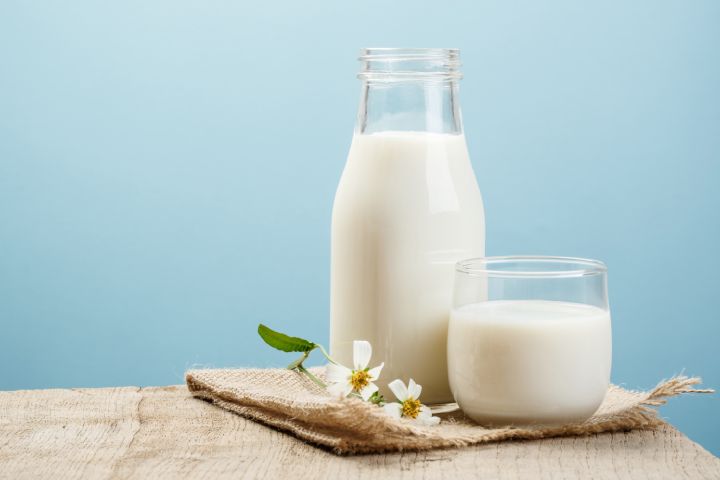
Image: Shutterstock
As a parent, it’s natural to want to give the best food with sufficient nutrients to your baby. If you are wondering when to dive into the delicious world of yogurt with your little one, you have come to the right place. Let’s scoop up the scoop on this creamy delight and see how to introduce it to your baby’s menu. Read on to know more!
When Can Babies Be Introduced To Yogurt
As your baby hits the exciting milestone of 6 months, you can introduce them to solid food (1). This stage marks the ideal time to start introducing yogurt into their diet. Yogurt, being a nutrient powerhouse, brings a blend of essential vitamins and minerals like calcium, protein, and probiotics — a beneficial mix that supports your baby’s growth and development (2). However, it’s vital to consult your pediatrician before introducing yogurt to ensure it aligns with your baby’s individual development and dietary needs. Their guidance can ensure that this creamy addition fits perfectly into your baby’s nutritional journey.
Introducing yogurt at this stage opens up a world of taste exploration for your little one. This creamy delight not only adds variety to their diet but also provides essential nutrients crucial for their development. Always remember, every baby is unique, and consulting your pediatrician before embarking on this dietary adventure ensures that your baby’s introduction to solids, including yogurt, happens at just the right moment for their healthy growth.
Nutritional Benefits Of Yogurt
Image: Shutterstock
1. Calcium Boost
Yoghurt is a calcium-rich treat, crucial for developing strong bones and teeth in growing babies. This mineral lays the foundation for healthy skeletal growth, supporting their little bodies as they explore the world.
2. Protein Powerhouse
Packed with protein, yogurt provides the building blocks for growing muscles. This nutrient aids in your baby’s physical development, helping them reach those adorable milestones.
3. Gut-Friendly Probiotics
Yoghurt contains probiotics, those friendly bacteria that work wonders for digestion. They help maintain a healthy balance in the gut, supporting your baby’s immune system and promoting a happy tummy.
4. Vitamin Bounty
Yogurt is also a fantastic source of essential vitamins like B12 and riboflavin. These vitamins play vital roles in your baby’s overall growth and development, contributing to various bodily functions and maintaining good health.
Easy Recipes With Yoghurt
1. Banana Yoghurt Smoothie
Image: Shutterstock
https://www.shutterstock.com/image-photo/vegan-banana-oatmeal-smoothie-glass-jar-1589333425
Ingredients
- 1 ripe banana
- ½ cup yogurt
- ¼ cup milk (optional)
- Honey or maple syrup (optional for sweetness)
How To Prepare
- Peel and slice the banana and add it to a blender.
- Add yogurt and milk, then blend until smooth.
- Taste and add honey or maple syrup for sweetness.
- Pour into a glass and serve this creamy, nutritious delight!
2. Avocado Yogurt Dip
Image: Shutterstock
Ingredients
- 1 ripe avocado
- ½ cup plain yogurt
- 1 tablespoon lemon juice
- Salt and pepper to taste
How To Prepare
- Scoop out the avocado flesh into a bowl and mash it well.
- Add the yogurt, lemon juice, salt, and pepper and mix until smooth.
- Serve as a dip with veggie sticks or spread it on toast for a creamy and healthy treat!
3.Yogurt Bites For Teething Babies
Image: Shutterstock
Ingredients
- Plain yogurt
- Mashed fruits or purees (like strawberries or peaches) (optional)
How To Prepare
- Fill an ice cube tray halfway with plain yogurt.
- For added flavor, add a dollop of mashed fruit or puree on top.
- Freeze until solid, then pop out the mini yogurt bites.
- Offer these frozen bites to soothe teething discomfort or as a delightful snack!
Differences Between Yogurt And Milk
Image: Shutterstock
1. Fermentation Process
Yogurt undergoes a fermentation process, in which bacteria (usually Lactobacillus bulgaricus and Streptococcus thermophilus) convert lactose (the natural sugar in milk) into lactic acid (3). This process breaks down some of the lactose, making yogurt easier to digest compared to milk for individuals who are lactose intolerant or have difficulty digesting lactose.
2. Probiotics
Yogurt is rich in probiotics, i.e., live bacteria and yeasts that are beneficial for gut health. These aid in maintaining a healthy balance of microorganisms in the gut. Probiotics aid digestion, help in boosting the immune system, and may even help alleviate certain gastrointestinal issues. Milk, on the other hand, does not naturally contain probiotics.
3. Nutritional Composition
While both milk and yogurt are excellent sources of calcium, protein, and other nutrients, yogurt typically contains a similar nutrient profile to milk but in a more concentrated form. It tends to have slightly more calories, protein, and calcium per serving compared to milk.
4. Texture and Taste
Yogurt has a thicker consistency and a tangy flavor due to the fermentation process, while milk is in its liquid form and has a milder taste. This difference in texture and taste makes yogurt a versatile ingredient for various dishes and a more appealing option for some individuals, including babies transitioning to solid foods.
Best Kinds Of Yogurt
When picking yogurt for your baby, go for whole milk, plain yogurt without added sugars or artificial flavors. Keep an eye out for yogurt with probiotics — it’s fantastic for your baby’s digestion. And remember, organic yogurt can be a great choice, too.
In a nutshell, introducing yogurt to your baby’s diet is like giving them a tiny tub of nutrients and deliciousness. It’s a versatile food that can be whipped into various yummy treats, making mealtime a joy for both you and your little food explorer. So, grab a spoon and let the yogurt adventures begin!

















